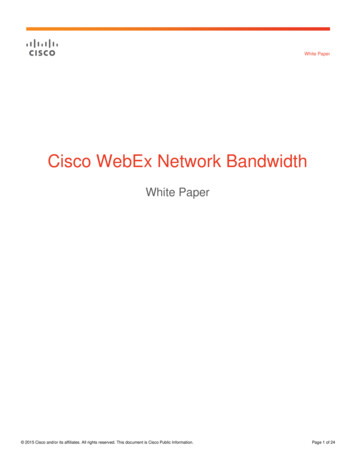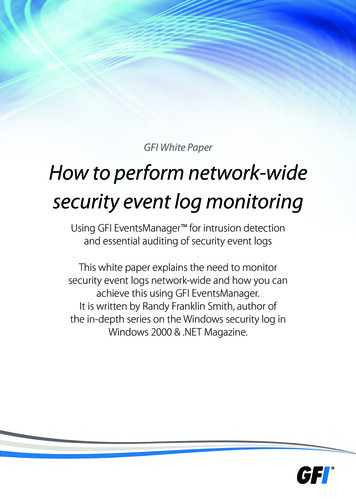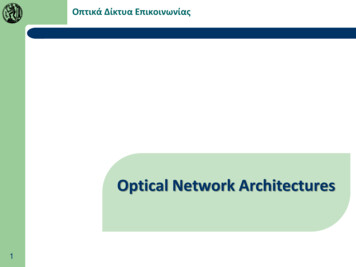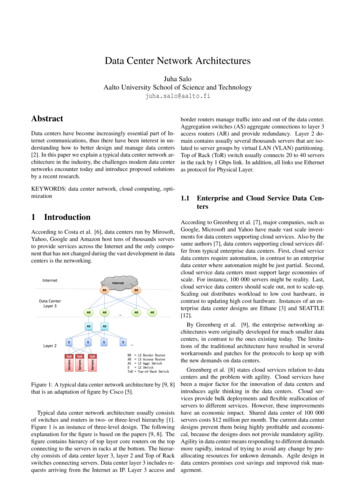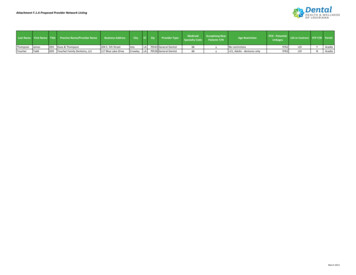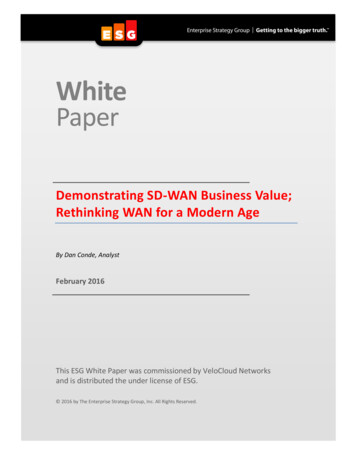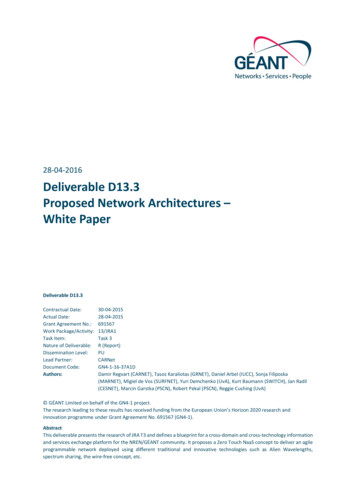
Transcription
28-04-2016Deliverable D13.3Proposed Network Architectures –White PaperDeliverable D13.3Contractual Date:Actual Date:Grant Agreement No.:Work Package/Activity:Task Item:Nature of Deliverable:Dissemination Level:Lead Partner:Document Code:Authors:30-04-201528-04-201569156713/JRA1Task 3R (Report)PUCARNetGN4-1-16-37A1DDamir Regvart (CARNET), Tasos Karaliotas (GRNET), Daniel Arbel (IUCC), Sonja Filiposka(MARNET), Migiel de Vos (SURFNET), Yuri Demchenko (UvA), Kurt Baumann (SWITCH), Jan Radil(CESNET), Marcin Garstka (PSCN), Robert Pekal (PSCN), Reggie Cushing (UvA) GÉANT Limited on behalf of the GN4-1 project.The research leading to these results has received funding from the European Union’s Horizon 2020 research andinnovation programme under Grant Agreement No. 691567 (GN4-1).AbstractThis deliverable presents the research of JRA T3 and defines a blueprint for a cross-domain and cross-technology informationand services exchange platform for the NREN/GÉANT community. It proposes a Zero Touch NaaS concept to deliver an agileprogrammable network deployed using different traditional and innovative technologies such as Alien Wavelengths,spectrum sharing, the wire-free concept, etc.
Table of ContentsExecutive Summary11Introduction42Zero Touch Networking52.1Zero Touch Provisioning Concept62.2Existing Zero Touch Provisioning 92.2.4Brocade102.2.5Overture102.2.6Allied Telesis112.2.7Aruba112.2.8Optical Zero Touch122.334Bare Metal Zero Touch Approach (and SDN/NFV)14Enabling Zero Touch Operation and Management with Network-WideOrchestration163.118Zero Touch Network as a ServiceZero Touch Provisioning Cloud Infrastructure224.1Motivation for ZTP Cloud Infrastructure224.2ZTP Cloud Infrastructure Components234.3Open Cloud Exchange (OCX)254.3.1Open Cloud Exchange Architecture (and Design Principles)254.3.2OCX Requirements274.3.3OCX Functional Components and Design274.3.4Enabling Technologies294.4OCX Demonstration325Towards a Cloud-Aware Network Architecture356Conclusions39Appendix AA.1Appendix BOpen Cloud Exchange and SDN-Enabled CSDI Demonstration41Technical Description of the Supercomputing 2015 Demo41OCX Functional Components and Design46Deliverable D13.3Proposed Network Architectures – White PaperDocument Code: GN4-1-16-37A1Di
ContentsB.1.1Appendix COCX Use ScenarioDissemination of Work4749References50Glossary55Table of FiguresFigure 2.1: Illustration of the steps involved in the traditional network deviceprovisioning process7Figure 2.2: Illustration of the process of Zero Touch network device provisioning8Figure 2.3: Open networking architecture using bare metal devices [BMWBS]15Figure 3.1: ZTP platform integration using AssureNow [MAN]17Figure 3.2: Zero touch network level orchestration and management model19Figure 3.3: Agile, assured and orchestrated with NFV use case diagram [MEF]20Figure 4.1: Zero touch Network as a Service model (OCX use case scenario)24Figure 4.2: gOCX building blocks28Figure 4.3: GÉANT’s Cloud Marketplace32Figure 4.4: SC15 demonstration scenario33Figure 5.1: Main elements defining a service as depicted by TOSCA37Figure A.1: Parties involved in the demo42Figure A.2: The graphical user interface used by the clients in the demo42Figure A.3: Example video processing paths that can be defined using SFC43Figure A.4: Network setup of the demo scenario44Figure A.5: SFFs and SFs setup in the ZT OCX demo scenario45Deliverable D13.3Proposed Network Architectures – White PaperDocument Code: GN4-1-16-37A1Dii
Executive SummaryTraditional networks are gradually becoming obsolete, as they are unable to handle the increasingstrain placed on their available resources by the various “heavy-weight” requirements of emergingapplications. Network data flows in this highly dynamic environment, where the computing focus hasshifted from local servers to the cloud, have vastly increased in volume, while at the same time beingless tolerant to delays and jitter due to their time-sensitive nature.As real-time stream processing of big data on high-performance computing resources in the cloudcontinues to grow, it is of fundamental importance that the next generation networks implementedby GÉANT and the NRENs are capable of agilely handling and adapting to this burden. This means thata future network architecture to support the emerging demands of the R&E community must rely onan agile backbone and aggregation links that are part of a highly automated, programmable network,capable of responding to individual user requirements by exhibiting application and cloud awareness.The future GÉANT network must maintain standards of efficiency and resiliency while providing aflexible and scalable service delivery infrastructure providing dynamic end-to-end connections ondemand that will offer a higher quality of experience (QoE) to its end users.A high QoE can only be delivered if the underlying network is dynamic and flexible enough to beresponsive and able to adapt to an environment in a rapidly changing environment in which complexservices are constantly evolving. The network must not only provide automatic connections fordevices, but even more importantly the automatic provisioning of network resources must beimplemented on all layers based on application and service requirements. This will enable a zeroeffort, highly efficient utilisation of network resources for end users, who will experience the agilenetwork that provides connectivity to their needed services as Zero Touch (ZT). Using the Zero Touchparadigm, the underlying network will be able to adapt to the requirements of the requested serviceand control all flows, with the aim of providing a high level of QoE for the user no matter which deviceis used to connect to the network.This convergence between the services offered and the delivery network infrastructure has manybenefits for both end users and network administrators. The Zero Touch network-as-a service-conceptoffers a higher value service to the end users while simultaneously significantly lessening the burdenon network administrators for provisioning and managing the network devices. The concept ofautomation offered by the Zero Touch paradigm also involves end users and developers as activeparticipants in the control of their traffic flows. Enabling the end connection points to have an activerole in traffic management ensures that the requested requirements and constraints are taken intoconsideration.Deliverable D13.3Proposed Network Architectures – White PaperDocument Code: GN4-1-16-37A1D1
Executive SummaryHowever, in order to fully exploit the Zero Touch paradigm, there must be agile responsiveness toend-user requirements along the whole end-to-end connection, which in most cases falls acrossmultiple network domains, which requires seamless cooperation between the GÉANT network andthe NRENs. This can be achieved by developing an orchestration layer that will practically collapse thenetwork domain boundaries to provide user-controlled configuration and provisioning of a full endto-end path in the multi-domain environment of the R&E community. In this way, a complete ZeroTouch network as a service (NaaS) can be offered to the end user. Based on this model the user canset up and tear down multi-domain connections between any two (or more) points that can bereached in the merged GÉANT/NREN networks.Given the above, user QoE could be further enhanced by establishing a tight, federation-basedcooperation between GÉANT and the NRENs as network infrastructure providers and the serviceproviders (i.e. commercial cloud providers, or specialized research oriented providers). It should benoted here that NRENs maintain a high level of cooperation, where commercial networks do not.Therefore, technologies/architectures requiring a high level of cooperation between networks (as inan inter-domain multipath environment) are unlikely to be developed by commercial network serviceproviders, which places NRENs in a good position to launch this new networking paradigm.With such a federation-based cooperation in place, a complete Zero Touch service can be offered aspart of a service catalogue, and once requested by a user can be provided via an end-to-endconnection established on-demand using the underlying ZT NaaS. This integration between thenetwork and the services offered on top of it opens up possibilities for establishing a marketplacewhere the service providers can offer their services to the end users.Joint Research Activity 1 – Task 3 has researched and defined a blueprint for the cross-domain andcross-technology information/services exchange platform for the NREN/GÉANT community. The taskalso aimed to test and demonstrate current, emerging and potential new technologies to provide aproof of concept for the implementation of innovative intelligent network services within GÉANT. Thedemo environment developed could be extended to create a testbed environment for emergingnetwork technologies in the future.The research presented in this white paper is a natural extension of the scope of connection-orientedservices such as Bandwidth-on-Demand and Multi Domain VPN to an end-to-end service. The ZT NaaSconcept presented can be employed to deliver an agile programmable network deployed usingdifferent traditional and innovative technologies such as Alien Wavelengths, spectrum sharing, thewire-free concept, etc. The key results from the research presented here point towards an innovativeframework for delegating local networking resources to remote users in a controlled way.The research especially focused on investigating the feasibility of cross-domain network solutions thatcan support various (complex) services benefiting from the open exchange philosophy. By bringing theNRENs, GÉANT and commercial service providers together, capitalising on the federated use ofnetwork resources, openness, and integration, a service architecture based on an application- andcloud-aware intelligent programmable network is proposed. The architecture directly supports thenetwork requirements and demands defined within the user applications, in particular scientificworkflows using big data, by including network topologies and network QoS requirements in theapplications’ description and design, in particular by extending the OASIS TOSCA standard acceptedby the industry.Deliverable D13.3Proposed Network Architectures – White PaperDocument Code: GN4-1-16-37A1D2
Executive SummaryOpen Cloud Exchange (OCX) was adopted as a use case on top of which the Zero Touch Network as aService model was applied to demonstrate the benefits of the multi-domain Zero Touch paradigm. Ademonstration presented at the Super Computing conference in Austin in November 2015 showedthe value of the approach that has been adopted, which brings the benefits of the on-demand usercontrolled agile network infrastructure closer to the public, exhibiting outstanding QoE and flexibility.Deliverable D13.3Proposed Network Architectures – White PaperDocument Code: GN4-1-16-37A1D3
1IntroductionThe last decade has witnessed a great expansion in the field of data acquisition and processing, led bythe proliferation of services offered to end-users. Traditional networks are gradually becomingobsolete, as they are unable to handle the increasing strain placed on their available resources by thevarious “heavy-weight” requirements of emerging new applications.To investigate possible solutions to the needs identified in the area of future network design, the maingoal of Joint Research Activity 1 – Task 3 was to research and define the blueprint for the cross-domainand cross-technology information and services exchange platform for the NREN/GÉANT community.The task also aimed to test and demonstrate current, emerging and potential new technologies toprovide a proof of concept for the implementation of innovative intelligent network services withinGÉANT.The document first introduces the Zero Touch concept, based on a bottom-up approach starting fromnetwork device provisioning. The current implementations of Zero Touch provisioning are alsoinvestigated as well as the possibility of extending the concept to a multi-domain agile network thatcan provide self–servicing. The section on ZT OCX extends the Zero Touch paradigm to the OCXarchitecture. The different complex multi-cloud service provisioning scenarios using Zero Touchcombined with OCX are discussed, further focusing on the OCX architecture and the components ofthe proposed automated network-as-a-service (NaaS) provisioning.This is followed by a discussion of the integration of the NaaS provisioning with the developmentprocess for new cloud-based applications that can benefit from user-controlled end-to-endconnection. As a further step towards the creation of composite cloud- and application-awarenetworks, the possibility of setting up a marketplace for publishing and offering services to end-userson top of the ZT NaaS model is also examined. Finally, the conclusion summarises the researchfindings. The technical details of the Super Computing demonstration are included in Appendix A.Deliverable D13.3Proposed Network Architectures – White PaperDocument Code: GN4-1-16-37A1D4
2Zero Touch NetworkingIn today’s constantly evolving scenario, the network design and optimisation process must take intoaccount the continuous addition of new services, especially those requiring specific QoS levels, suchas minimum bandwidth and latency for real-time multimedia streaming. This moreover places agreater operational burden on network administrators as it makes the day-to-day networkmanagement and optimisation increasingly complex and time consuming [NMS]. A flexible andaccessible Zero Touch network, therefore, should not only respond to user requirements seamlesslyand automatically, but also be easily managed and implemented so as not to overburden networkmanagers.Substantial effort has been invested in the field of network ma
Zero Touch Networking Deliverable D13.3 Proposed Network Architectures – White Paper Document Code: GN4-1-16-37A1D 9. unmanned network setup and configuration for different NREN clients, e.g. remote setup of new devices on the premises of schools or research facilities using Zero Touch.File Size: 1MBPage Count: 59
